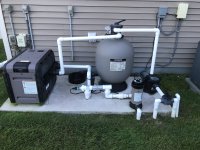Ok great !! Hang tight for any thoughts of current models. Mine is long discontinued and they don’t make em like they used to. If you want to start looking, they all brag about the PSI but you only need a few. (5-7 ?), so in that regard any compressor would work. But what you really need is a higher CFM and that # can be manipulated to make some models look better. So what you really really want is the highest SCFM (standard cubic feet per minute) which levels the playing field for manufacturers claims. Technically all you need is 1-2 CFM if it’s a true measurement, so maybe look closer towards the 5 CFM models. They get real pricey after that.
Interesting and a first for me. Are the returns above the water once drained ? Maybe they have some sort of check valve built into them ? If not they’d need to be plugged. If they are below the waterline and don’t plug themselves get blow through bungee plugs. They seal up once the compressor air stops.
If they are high and dry once drained get standard screw in ‘winterizing plugs’
 So I’ve gotten accustomed to opening my pool by myself for two seasons now. However , I would like to start closing it myself. The pool store charges almost $200 to close my pool and I don’t know if I want to go pay that right now. The pool store uses a cyclone Compressor.
So I’ve gotten accustomed to opening my pool by myself for two seasons now. However , I would like to start closing it myself. The pool store charges almost $200 to close my pool and I don’t know if I want to go pay that right now. The pool store uses a cyclone Compressor.
